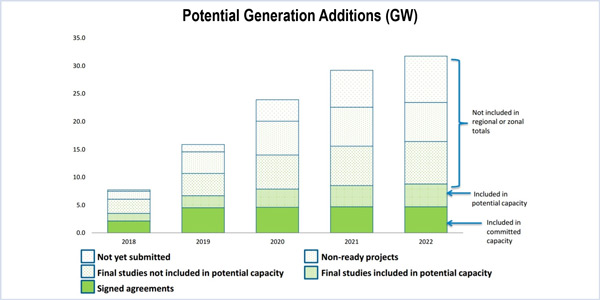By Amanda Durish Cook
BRANSON, Mo. — MISO will have adequate generation over the next five years to address its changing resource mix and the adoption of new technologies, planning staff told RTO leaders last week.
Low electricity demand plays a big part in the brighter forecasts and more optimistic tone adopted by MISO when discussing future resource adequacy, staff say.
“Energy efficiency has made our load essentially flat since 2008,” Clair Moeller, MISO executive vice president of operations, said during a June 20 meeting of the Board of Directors’ System Planning Committee.
The RTO’s annual resource adequacy survey published jointly with the Organization of MISO States earlier this month found that low demand will leave its footprint flush with capacity through at least 2022. The survey showed a 2.7- to 4.8-GW regional surplus over the next five years, while last year’s survey predicted a 0.4-GW shortfall by 2018 if no new generation came online. (See Capacity Survey Shows MISO in the Black.) MISO expects peak loads of more than 130 GW by 2032. Current summer peak is expected to hit about 125 GW.
Director Phyllis Currie asked what MISO is receiving from states in terms of resource planning.
Jennifer Curran, MISO vice president of system planning, pointed to a new level of fuel diversity in states’ integrated resource plans, which typically chart a resource mix that is one-third each coal, natural gas and either wind or nuclear generation.
“The old days were a preponderance of coal; the new days are a preponderance of gas,” Moeller said.
Wind projects still occupy about a 67% share of the current 32 GW of new generation in the RTO’s interconnection queue. Moeller expects fewer wind projects to enter the queue as federal production tax credits are phased out.
Planners think batteries do not yet make financial sense in the MISO footprint. “We think we have some time to work through how to do the math to optimize storage,” Moeller said.
However, MISO is hedging bets this year by introducing a fourth 2018 Transmission Expansion Plan 15-year future scenario that envisions a surge in rooftop solar, localized storage devices and electric vehicle use. (See “MISO Tweaks 4th and Newest MTEP Future,” MISO Planning Advisory Committee Briefs.)
“Now the electric vehicle folks are sure this is going to happen, and the solar collector folks are sure this is going to happen,” Moeller joked. “We’ll see. What we need to ensure is that we have the grid for the future when the future gets here.”
MISO still expects emerging technology like solar to increase the complexity of transmission planning and noted that demand-side programs have the potential to “fundamentally change load levels and shapes.”
Moeller noted that the Department of Energy forecasts even higher future solar penetration than MISO’s highest predictions.
“We’re not quite sure where their optimism comes from, but that’s where it is,” Moeller said.
An Energy Information Administration report released early this year projects that the U.S. will add nearly 70 GW of new wind and solar photovoltaic capacity from 2017 to 2021. Solar will be one of the “most competitive sources of new generation” by 2022 and will represent more than 50% of new capacity additions between 2030 and 2040, according to the agency.





